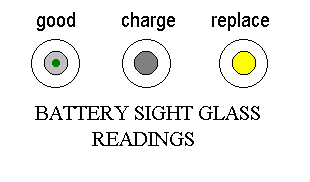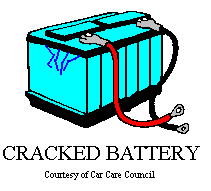Inspecting Your Battery
*EASY*
Inspect the battery according to the following procedure:
- Park the vehicle on level ground in a well-ventilated area with the engine
OFF, the parking brake engaged, and the transmission in PARK (for automatic) or
REVERSE (for manual). Raise the hood. Identify the battery using your owner's
manual. It will have two large electrical cables, one red and the other black,
connected to it.
- Make sure the cables are firmly connected to the battery terminals and that the cable insulation is not torn. If torn, cover the cable insulation with electrical tape. If the cable clamps are damaged and do not permit a tight hold on the battery terminals, have the cables replaced by a professional automotive technician. Make sure the battery is firmly secured in the battery tray. Excessive vibrations could damage internal parts.
- If your battery has removable caps, unscrew them and check level of the electrolyte solution. If your battery has gang vent covers, pry off the covers with a screwdriver. View the electrolyte solution in the battery cells; the cells should be full. If the solution is low, add only pure distilled water to the appropriate level, usually 1/4-1/2" above the top of the lead plates. The correct level may be signified by a guide (split) ring on the cell. Do not use tap water; it may contain salt, minerals or other impurities. Do not add electrolyte (battery acid); it could shorten the battery's life. Fill the cells using a plastic funnel; a metal funnel inserted deeply into the battery may cause a short circuit between the plates. Do not overfill with distilled water or the electrolyte will be diluted and the battery will be weakened. Replace the caps or covers as appropriate.
- If your battery is sealed (maintenance-free), it should have a built-in
hydrometer. The hydrometer
measures the concentration of the electrolyte and, therefore, strength of your
battery. Look for a small, circular sight
glass in the top of the battery. Wipe off any dirt or grease for an
accurate reading. If the sight glass is dark and has a green dot, the battery
strength is fine. If the indicator is dark but has no green dot, the battery
needs charging. If the sight glass is yellow or clear, the battery must be
replaced.
If your battery has no sight glass, refer to Testing Battery Strength. - Wipe all grease, dirt, corrosion, and moisture from the top and sides of
your battery. Keep your battery clean since a layer of grease between the
terminals can cause it to lose power through a short circuit electrical drain.
- Look for cracks or bulges in the battery case. Cracks may permit electrolyte leakage. A cracked battery must be immediately replaced.
- Close the hood.



